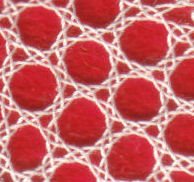


Kat stitch is a Bucks Point ground or open part of lace. It needs a reasonable area to make sense of the pattern. The pattern is similar to honeycomb - it just uses a different stitch at each pin. See pattern 235.
Kat stitch is reputedly named after Katherine of Aragon, the first queen of Henry VIII, who was supposed to be the person who introduced lacemaking into England - a nice story! But it could be named after St Catharine, patron saint of English lacemakers.
French terms for Kat stitch are as point de Paris and fond chant. Other English terms are six-point star, French ground, hairpin stitch and wire ground.

Pattern representation of kat stitch
Kat stitch uses a Bucks Point grid, with lines at 60° (rather than Torchon's 45°). The tradition pattern of kat stitch may just give the pinholes. I prefer to mark out exactly where the pairs go - see above right.
All stitches in kat stitch are the same. They are half stitch, pin, half stitch (like Torchon ground). See diagram below:
|
|
This shows how the pairs travel through kat stitch. The pairs swap over at every pin.

The following diagram avoids the complexities of the individual stitches by showing each pair of threads as a single line. Where one line crosses another, you should work it as above, in half stitch, pin, half stitch.
The diagram shows several rows of kat stitch. The first row is outside the kat stitch, but sets up the pairs of bobbins in the right place. You will also see pairs appearing from the left or right, which happens in kat stitch. It does not have a neat edge!
|
|
Working: Kat stitch is worked in diagonal rows. The diagram shows rows from upper left to lower right. It is possible to work kat stitch sloping the other way.
Row 1: The worker pair is the left of the top two pairs. Work it across all other pairs.
Row 2: Work the top two pairs. Then discard them, and take the next two pairs and work them, and so on. This creates a pattern of triangles.
Row 3: as row 1 - work a pair from the left across all other pairs.
Row 4: as row 2 - work top two pairs, discard them, work the next two pairs, etc.
And so on. If the patterns show lines, then make sure that your threads follow the lines. This will help you choose the correct two pairs for each pin.
Some patterns may have Kat stitch worked at half the size, so it takes up the same amount of space as Bucks Point net. Instead of having pins around the six 'points' of the star, it uses a single pin in the center, similar to Bucks point net. To keep the grids lined up, I think its pinholes were also shifted up half a space. This might be fiddly to work!
Here is an example of Binche lace (I think) from my lace collection. There are no pinholes visible in the Kat stitch.

© Jo Edkins 2016 - return to lace index